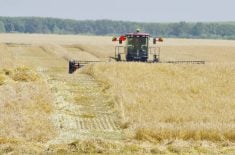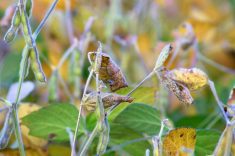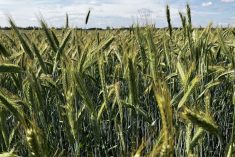Parts of Manitoba finally got rain going into the long weekend. Before that though, it was worryingly dry for farmers seeding their 2025 crop.
This spring has seen a return of worries seen in other dry years: emergence concerns for oilseeds, seed treatment efficacy and soil crusting.
“It definitely has cooled off from the heat we’ve been getting, and maybe that’ll bring some rain on, but right now there’s no rain in some areas,” said Lionel Kaskiw, a crop production specialist with Manitoba Agriculture, on May 14.
Read Also

Manitoba boosts stake in cereals centre to $23.5 million
Premier Wab Kinew said the additional project funds will help ‘Trump-proof’ the provincial economy.
WHY IT MATTERS: Manitoba has suffered string of grass fires and out of control wildfires that have damaged property, led to evacuations in northern and eastern Manitoba and killed two people due to lack of moisture this spring.
The May 13 Manitoba Crop report noted that most areas had seen less than half their normal moisture at that point in May.
About 32 per cent of Manitoba’s cropland had been seeded in those conditions, according to Manitoba Agriculture data.
“I think any rains we have been getting have been the spotty-type showers that maybe only hit a small area, “ Kaskiw said.
Turn in the weather
Even as Kaskiw spoke, however, there was hope of rain.
Overland flood warning were issues for parts of western Manitoba due to significant rainfall expected coming into the May long weekend.
May 15, which had the heaviest rainfall forecast, saw up to 47 millimetres fall on the southwest and up to 36 millimetres in the Interlake, although Interlake totals were much more sporadic and some areas registered little precipitation. In the fire-imperiled east, most totals for the day came in under 25 millimetres, while the northwest tapped out at 20 millimetres in most areas.
Central Manitoba, meanwhile, saw the heaviest rain. Over 63 millimetres fell on Somerset, according to Manitoba Agriculture, and accumulations between 30-50 millimetres were widespread.
At the same time, temperatures plummeted from record highs and heat warnings to near freezing.
It’s a trend Kaskiw hopes doesn’t last too long.
“We don’t want the same situation as last year, where we had some emergence problems with canola because of the wet, cool conditions,” he noted.

Canola emergence dependent on moisture levels
The small, shallow-seeded canola seeds need moisture in the top inch of soil, experts noted.
“Having just a bit of moisture for it to be able to pop through is really key,” said Sonia Wilson, an oilseeds specialist with Manitoba Agriculture.
For those that missed rain in the third week of May, rough stubble and crusting may be a problem, she noted.
High clay soils are particularly susceptible to crusting. Light tillage can help, but it will also eat away at moisture, she warned
Warm temperatures have also led to rapid weed growth on oilseed fields.
“Those…weeds, even if they are small, are taking moisture away from those smaller seeded crops as well,” Wilson said.
Oilseed producers facing dry conditions during seeding have a few options, Wilson said.
Producers are generally warned against chasing moisture. Seeding slightly deeper is an option, Wilson noted, but cautioned that it’s a risky choice.
“It’s going to affect the canola emergence, and then also potentially, if it’s emerging poorly, (it could) also lead to a thinner stand and, potentially, more flea beetle damage per plant,” she said.
Wilson recommends seeding from half an inch to one inch deep, though one inch is preferable.
“I would personally shy away from 0.5 inches, just because of the high winds that we’re experiencing as well, and the soil movement,” she said.
Depth should be consistent, and good packing on the seed row is necessary to protect the seeds from high winds. Seed depth should be checked after a pass or two to ensure consistency.
Sometimes, she added, it’s preferable to decrease seeding speed to achieve precision.
Flax and sunflower considerations in dry conditions
Flax is particularly challenged by dry conditions. It’s roots don’t go as deep as some other oilseed crops.
“It really requires having a moist, firm, even seed bed as much as possible to really help support its emergence,” Wilson said.
She puts flax seeding depth as one to one-and-a-half inches deep.
“If there is some moisture in that top one-and-a-half inch, then ensure that there’s really good packing for seed bed and moisture, especially with the high winds we’re seeing. Make sure your flax is packed good,” Wilson said.

Sunflowers should be seeded at one-and-a-half to two inches deep. They can be planted a little deeper than two inches if soil moisture is lacking, webinar attendees heard.
Sunflower seeds can sit safely in the soil before germinating, and the plant has deep roots that will allow it to pull moisture and nutrients from the soil, making them hardier against dry conditions.
“In terms of root structure, to get those seedlings going, it is one of the best crops,” Wilson said. “Check that depth, just to make sure it’s consistent for seeding.”
Seed treatment effectiveness
Seed treatments are also vulnerable to dry conditions.
The product activates at germination. After that, in the case of flea beetles, it’s a race to get the crop growing and thriving before the treatment effectiveness window runs out.
Heavy rains, on the other hand, can risk diluting seed treatments, which can lead to fewer days of protection, webinar attendees hear.















